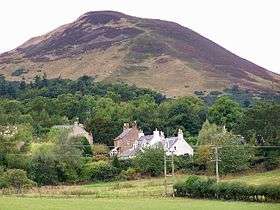Eildon Hill
| Eildon Hill | |
|---|---|
 Eildon Hill North, with Eildon Village in the foreground | |
| Highest point | |
| Elevation | 422 m (1,385 ft) |
| Prominence | c. 164 m |
| Listing | Marilyn |
| Naming | |
| Translation | possibly "Elves Hill" (Old English) |
| Pronunciation | /ˈiːldən/ |
| Geography | |
| Location | Scottish Borders, Scotland |
| Parent range | According to Nuttall, the 1,385 feet (422 m) high "triple-crested eminence" overlooks Teviotdale to the South. |
| OS grid | NT548322 |
| Topo map | OS Landranger 73 |
- Not to be confused with Eldon Hill, England
Eildon Hill lies just south of Melrose, Scotland in the Scottish Borders, overlooking the town. The name is usually pluralised into "the Eildons" or "Eildon Hills", because of its triple peak. The 1,385 feet (422 m) high eminence overlooks Teviotdale to the South.
The north hilltop (of three peaks) is surrounded by over 5 km (3.1 mi) of ramparts, enclosing an area of about 16 ha (40 acres) in which at least 300 level platforms have been cut into the rock to provide bases for turf or timber-walled houses.
The mid hilltop is the highest and has a monument to Sir Walter Scott on it. The south hilltop is the lowest. The Eildon hills are surrounded by a large area of woodlands, home to wildlife such as roe deer, badgers, stoats and foxes. In winter and early spring the Eildon Hills are often covered in snow, although snow lasts longer on the higher slopes of the neighbouring Southern Uplands.
History
Excavations have found evidence that the hill fort was occupied by 1000 BC, in the Bronze age. The ramparts seem to have been built and rebuilt in three phases. At its peak the population of the hill could have been 3000 to 6000, the largest known in Scotland from this period. Evidence has not been found of a significant population in the immediate pre-Roman period.
In the 1st century the Roman army built the massive fort of Trimontium, named after the three peaks, at the foot of the hill on the bank of the River Tweed. In association with it they constructed a signal tower with a tiled roof in an 11 m (36 ft) diameter enclosure built on the summit of the hill fort, which presumably had been abandoned. However, finds including Roman coins and pottery have suggested that some of the house platforms were again in use in the 2nd to 4th century. It was once widely believed that this Trimontium might be the Trimontium of the Selgovae that had been mentioned by the Roman geographer Ptolemy, but the source of the information was later discredited.
There is some evidence that prehistoric peoples regarded the Eildon Hills as a holy place and scholars believe they may have been a place of ceremonial gatherings. There are several holy springs around the base of the hills, now dedicated to Christian saints, but probably originally sacred to Celtic deities.[1]
Formation
It is possible that the Hill was formed deep beneath the Earth's surface as ancient laccoliths.
Folklore

Eildon is said to be a "hollow hill", and is mentioned in the legend of Thomas the Rhymer. Some believe Thomas went under the hill itself, and certainly part of the ballad occurs in the vicinity. Sir Walter Scott tells the tale of a horse dealer who is paid in 'ancient coin' by an elderly buyer in old-fashioned dress and taken inside the hill at night. A host of armed knights lie asleep at their horses' feet; their sleeping leader is King Arthur. Shown a horn and a sword, in confusion the dealer blows the horn: the men begin to awake and a loud voice indicates that he has been proved a coward for not seizing the sword first. A whirlwind ejects him from the chamber and outside he tells his story to some shepherds before dropping dead of exhaustion. Scott identifies the elderly man as Thomas the Rhymer.[2][3]
The volcanic rock was "said to have been cleft in three by the wizard Michael Scot when he was out of employment", and this story is repeated in James Hogg's 1823 novel - The Three Perils of Man .
Media
This place was cited in the lyric 'Eiledon', from Big Country's 'The Seer' album.
See also
Notes
References
- Scotland Before History - Stuart Piggott, Edinburgh University Press 1982, ISBN 0-7486-6067-4
- Scotland's Hidden History - Ian Armit, Tempus (in association with Historic Scotland) 1998, ISBN 0-85224-348-0
- AQA A2 Geography - Amanda Barker, David Redfern, Malcom Skinner, Phillip Allan Updates 2008
This article incorporates text from a publication now in the public domain: Wood, James, ed. (1907). "article name needed". The Nuttall Encyclopædia. London and New York: Frederick Warne.
Coordinates: 55°34′53″N 2°43′07″W / 55.58134°N 2.71855°W